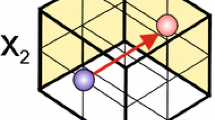Summary
A new method for display and analysis of lipophilic/hydrophilic properties on molecular surfaces is presented. The present approach is based on the concept of Crippen and coworkers that the overall hydrophobicity of a molecule (measured as the logarithm of the partition coefficient in an octanol/water system) can be obtained as a superposition of single atom contributions. It is also based on the concept of molecular lipophilicity potentials (MLP) first introduced by Audry and coworkers in order to establish a 3D lipophilicity potential profile in the molecular environment. Instead of using a l/r- or an exponential distance law between the atomic coordinates and a point on the molecular surface, a new distance dependency is introduced for the calculation of an MLP-value on the solvent-accessible surface of the molecule. In the present formalism the Crippen values (introduced for atoms in their characteristic structural environment) are ‘projected’ onto the van der Waals surface of the molecule by a special weighting procedure. This guarantees that only those atomic fragments contribute significantly to the surface values that are in the close neighbourhood of the surface point. This procedure not only works for small molecules but also allows the characterization of the surfaces of biological macromolecules by means of local lipophilicity. Lipophilic and hydrophilic domains can be recognized by visual inspection of computer-generated images or by computational procedures using fuzzy logic strategies. Local hydrophobicities on different molecular surfaces can be quantitatively compared on the basis of the present approach.
Similar content being viewed by others
References
M.Delaage, Physico-chemical aspects of molecular recognition, In Delaage, M. (Ed.), Molecular Recognition Mechanisms, VCH Publishers, New York, 1991, pp. 1–14.
Kauzmann, W., Adv. Prot. Chem., 14 (1959) 1.
Suzuki, T. and Kudo, Y., J. Comput.-Aided Mol. Design, 4 (1990) 155.
Tanford, C., The Hydrophobic Effect: Formation of Micelles and Biological Membranes, Wiley, New York, 1973.
Fujita, T., Iwasa, J. and Hansch, C., J. Am. Chem. Soc., 86 (1964) 5175.
Nys, G.C. and Rekker, R.F., Chim. Thér., 8 (1973) 521.
Rekker, R.F., The Hydrophobic Fragmental Constants, Elsevier, New York, 1977.
Hansch, C. and Leo, A., Substituent Constants for Correlation Analysis in Chemistry and Biology, Wiley, New York, 1979.
Connemann, M., Untersuchungen zur Thermodynamik wässriger zweiphasiger Polymersysteme und Bestimmung-von Proteinverteilungskoeffizienten in diesen Extraktionssystemen, Thesis, Darmstadt, 1992.
Kellogg, G.E. and Abraham, D.J., J. Mol. Graphics, 10 (1992) 212.
Broto, P., Moreau, G. and Vandycke, C., Eur. J. Med. Chem. Chim. Thér., 19 (1984) 71.
Ghose, A.K. and Crippen, G.M., J. Comput. Chem., 7 (1986) 565.
Ghose, A.K., Pritchett, A. and Crippen, G.M., J. Comput. Chem. 9 (1988) 80.
Viswanadhan, V.N., Ghose, A.K., Revankar, G.R. and Robins, R.K., J. Chem. Inf. Comput. Sci., 29 (1989) 163.
Lichtenthaler, F.W., Immel, S. and Kreis, U., Starch/Stärke, 43 (1991) 121.
Lee, B. and Richards, F.M., J. Mol. Biol., 55 (1971) 379.
Connolly, M., Science, 221 (1983) 709.
Quarendon, P., Naylor, C.B. and Richards, W.G., J. Mol. Graphics, 2 (1984) 4.
Heiden, W., Schlenkrich, M. and Brickmann, J., J. Comput.-Aided Mol. Design, 4 (1990) 255.
Audry, E., Dubost, J.-P., Colleter, J.-C. and Dallet, P., Eur. J. Med. Chem. Chim. Thér., 21 (1986) 71.
Furet, P., Sele, A. and Cohen, N.C., J. Mol. Graphics, 6 (1988) 182.
Croizet, F., Langlois, M.H., Dubost, J.P., Braquet, P., Audry, E., Dallet, P. and Colleter, J.C., J. Mol. Graphics, 8 (1990) 153.
Eisenberg, D., Weiss, R.M. and Terwilliger, T.C., Nature, 299 (1982) 371.
Eisenberg, D. and McLachlan, A.D., Nature, 319 (1986) 199.
Fauchère, J.-L., Quarendon, P. and Kaetterer, L., J. Mol. Graphics, 6 (1988) 203.
Brasseur, R., J. Biol. Chem., 266 (1991) 16120.
Reif, F., Statistische Physik und Theorie der Wärme, 2nd edn., de Gruyter, Berlin, 1985, p. 454.
Heiden, W. and Brickmann, J., in preparation.
Moeckel, G., Heiden, W. and Brickmann, J., in preparation.
Author information
Authors and Affiliations
Rights and permissions
About this article
Cite this article
Heiden, W., Moeckel, G. & Brickmann, J. A new approach to analysis and display of local lipophilicity/hydrophilicity mapped on molecular surfaces. J Computer-Aided Mol Des 7, 503–514 (1993). https://doi.org/10.1007/BF00124359
Received:
Accepted:
Issue Date:
DOI: https://doi.org/10.1007/BF00124359




